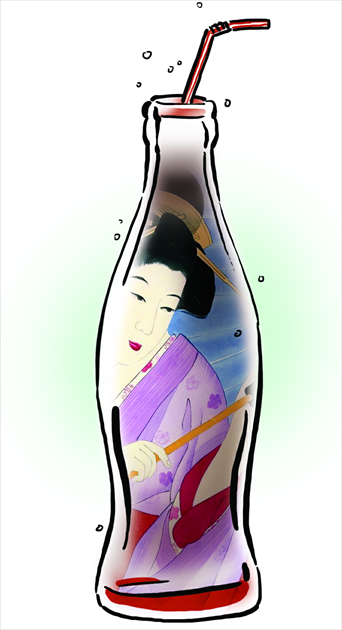Why is Japanese culture popular in US?

Illustration: Liu Rui/GT
Sushi, the small rolled rice with fish and vegetables is a common food for many Americans nowadays. You can find it easily in supermarkets, in restaurants, in offices and in homes across the US.
This traditional Japanese dish is famous in the US as a healthy alternative to heavier, fattier American fare. Although some sushi can be difficult to prepare, it is still a convenient option for countless office workers and families, no matter their lifestyle. It's no surprise that there are many kinds of American-style sushi invented for Americans' tastes.
Once a mysterious, remote oriental country, today's Japan is one of the US' closest friends. Japanese culture is becoming part of ordinary American people's daily lives: They eat sushi, drink sake, study judo, watch Japanese cartoons, and study the Japanese language.
From my point of view, one of the reasons why Japanese culture is popular in the US is that Japanese has become fused with American pop culture, rather than being exhibited solely in museums or taught only in a classroom.
Let me give an example. The flow of Japanese manga into the US has increased American awareness of Japanese animation. Unlike American superhero stories, Japanese cartoons are frequently fairy tales about magic, giving Americans a unique experience that they cannot find elsewhere.
Take Pikachu, a cute character popular among American kids and teenagers. Pikachu and other Pokémon appear frequently on T-shirts, TV shows, and websites, alongside traditional American icons like the Avengers, Batman and Superman.
Americans live in a multicultural society. They have embraced Japanese food, cartoons and other cultural elements because these have attracted attention and enriched lives.
An attractive culture is one that can be spread at a low cost, making a profit in today's consumer society.
With the help of mass media and marketing, Japanese food and animation is spreading throughout the US. Hundreds of derivative products are then released, and the snowball only grows larger, gathering speed as it rolls on.
Another reason why Japanese culture is popular in the US is that Japanese language education is becoming an "ecosystem," making it convenient for American students to understand and enjoy Japanese culture.
In University of California, San Diego (UCSD) where I am currently a visiting researcher, there is an institute called the Program in Japanese Studies.
The program coordinates a variety of campus offerings dealing with the history, culture and political economy of Japan for students majoring and minoring in Japanese, and brings together faculty including around 15 professors from various parts of the university.
In addition to this program, there are two more schools and four colleges in the UCSD offering over 20 Japanese language courses for all students, including extension and summer sessions. Assistant teaching positions and fellowship opportunities are always available for top graduates of Japanese language courses.
Eiko Ushida, a passionate Japanese language teacher in the UCSD's School of International Relations and Pacific Studies, illustrates the program's impact. She combines the best of both cultures, American and Japanese, with both humorous and serious sides.
Ushida believes that content-based instruction is very important in the language teaching process. She insists on teaching Japanese language and culture in Japanese instead of English. "Successfully teaching Japanese comes from a teacher's hard work and creative teaching methods," she said.
What's more, student organizations associated with Japanese culture, like the Japanese Student Association, UCSD Kendo Club, and Asayake Taiko, seem to be in fashion on campus.
On a macro scale, the US has over 150,000 Japanese learners, fifth in the world behind China, Indonesia, Korea and Australia.
According to the Survey Report on Japanese-Language Education Abroad 2012, issued by the Japan Foundation, the number of Japanese learners, institutions and teachers have all increased sharply in last several decades in the US.
This mixed American-Japanese culture can introduce Japan in a way that makes American comfortable. I call this process the "selective integration" of culture.
It doesn't matter whether pop Japanese culture in the US is entirely Japanese or not. The thing that matters is that American people like it, which helps Japanese culture take root in American society.
The author is a visiting researcher at University of California, San Diego. chenkangling@fudan.edu.cn